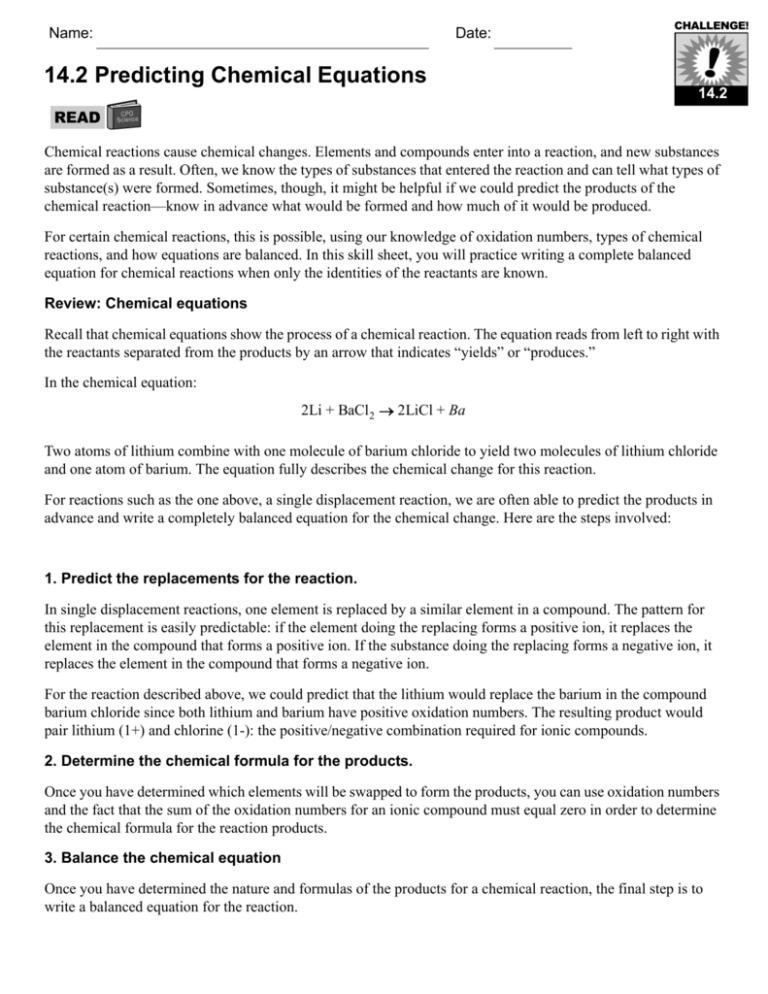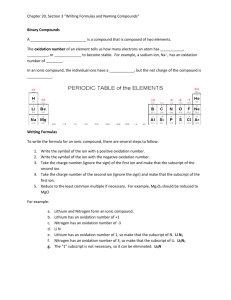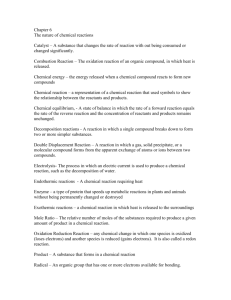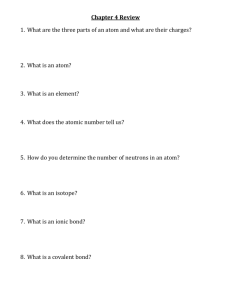14.2 Predicting Chemical Equations
advertisement

Name: Date: 14.2 Predicting Chemical Equations 14.2 Chemical reactions cause chemical changes. Elements and compounds enter into a reaction, and new substances are formed as a result. Often, we know the types of substances that entered the reaction and can tell what types of substance(s) were formed. Sometimes, though, it might be helpful if we could predict the products of the chemical reaction—know in advance what would be formed and how much of it would be produced. For certain chemical reactions, this is possible, using our knowledge of oxidation numbers, types of chemical reactions, and how equations are balanced. In this skill sheet, you will practice writing a complete balanced equation for chemical reactions when only the identities of the reactants are known. Review: Chemical equations Recall that chemical equations show the process of a chemical reaction. The equation reads from left to right with the reactants separated from the products by an arrow that indicates “yields” or “produces.” In the chemical equation: 2Li + BaCl2 → 2LiCl + Ba Two atoms of lithium combine with one molecule of barium chloride to yield two molecules of lithium chloride and one atom of barium. The equation fully describes the chemical change for this reaction. For reactions such as the one above, a single displacement reaction, we are often able to predict the products in advance and write a completely balanced equation for the chemical change. Here are the steps involved: 1. Predict the replacements for the reaction. In single displacement reactions, one element is replaced by a similar element in a compound. The pattern for this replacement is easily predictable: if the element doing the replacing forms a positive ion, it replaces the element in the compound that forms a positive ion. If the substance doing the replacing forms a negative ion, it replaces the element in the compound that forms a negative ion. For the reaction described above, we could predict that the lithium would replace the barium in the compound barium chloride since both lithium and barium have positive oxidation numbers. The resulting product would pair lithium (1+) and chlorine (1-): the positive/negative combination required for ionic compounds. 2. Determine the chemical formula for the products. Once you have determined which elements will be swapped to form the products, you can use oxidation numbers and the fact that the sum of the oxidation numbers for an ionic compound must equal zero in order to determine the chemical formula for the reaction products. 3. Balance the chemical equation Once you have determined the nature and formulas of the products for a chemical reaction, the final step is to write a balanced equation for the reaction. Page 2 of 2 14.2 • If beryllium (Be) combines with potassium iodide (KI) in a chemical reaction, what are the products? Solution: First, we decide which element of KI will be replaced by the beryllium. Since beryllium has an oxidation number of 2+, it replaces the element in KI that also has a positive oxidation number—the potassium (K1+). It will therefore combine with the iodine to form a new compound. Because beryllium has an oxidation number of 2+ and iodine's oxidation number is 1–, it is necessary for two atoms of iodine to combine with one atom of beryllium to form an electrically neutral compound. The resulting chemical formula for beryllium iodide is BeI2. In single-displacement reactions, the component of the compound that has been replaced by the uncombined reactant now stands alone and uncombined. The resulting products of this chemical reaction, therefore, are BeI2 and K. Balancing the equation give us: Be + 2KI → BeI2 + 2K Predict replacements 1. If Na1+ were to combine with CaCl2, what component of CaCl2 would be replaced by the Na1+? 2. If Fe2+ were to combine with K2Br, what component of K2Br would be replaced by the Fe2+? 3. If Mg2+ were to combine with AlCl3, what component of AlCl3 would be replaced by the Mg2+? Predict product formulas For the following combinations of reactants, predict the formulas of the products: 4. Li + AlCl3 5. K + CaO 6. F2 + KI Predicting chemical equations for displacement reactions Write complete balanced equations for the following combinations of reactants. 7. Ca and K2S 8. Mg and Fe2O3 9. Li and NaCl







